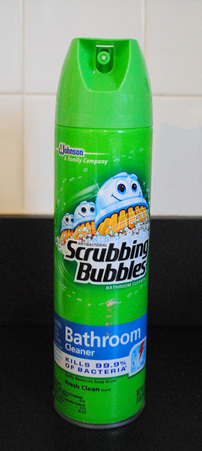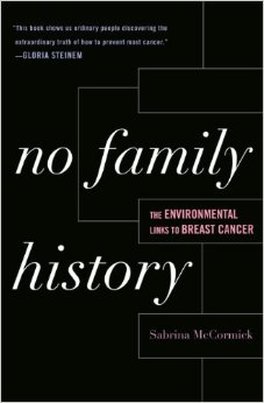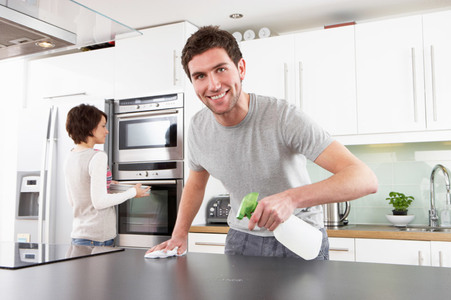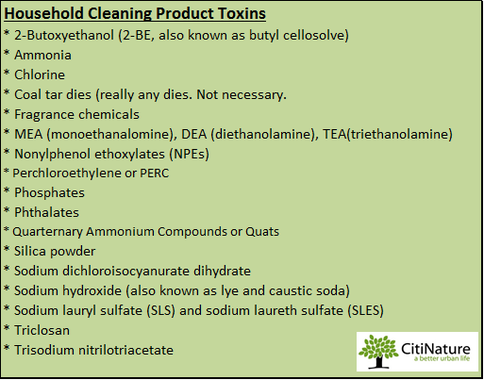 Lots of chemicals
Lots of chemicals Research suggests that environmental factors, in addition to behavioral contributors (such as diet and level of physical activity), play an important role in the development of cancer and other illnesses. Among these environmental factors, chemicals in the home are seen as an key contributor to high cancer rates. Children are especially vulnerable. But there's so much we don't know. What is clear is that the chemicals we use in everyday life can have a negative impact on us, even in small quantities when we are exposed over long periods of time. Each year we discover that yet another group of routinely used chemicals is carcinogenic. The list will keep growing. According to the U.S. government, only about 2% of chemicals on the market have been tested for carcinogenicity. What's more, the poor and less well-off tend to have more exposure to these chemicals due to the sorts of jobs they do, their lower levels of education and awareness, and the inability to pay for safer products. Consequently, they have higher cancer rates.

The fact is, we are exposed to toxic chemicals every day. For example, every time we use conventional cleaning products to clean the house we release toxins into the air, often onto our skin, and leave chemical residues on surfaces. It's rather ironic to think that we clean our homes to keep them healthy places but when using most household cleaning products we instead decrease home safety and in fact seriously increase health risks. A growing number of scientists believes that routine exposure to chemicals such as those found in home-cleaning products may be having an impact on cancer rates, with especially strong evidence linking their use to breast cancer. Because of the paucity of research in this area, a good guess is that the link between cleaning chemicals and breast cancer is only the tip of an iceberg. Much more research needs to be done.
A 2010 U.S. government report, Reducing Environmental Cancer Risk, states that “the true burden of environmentally induced cancers has been grossly underestimated.” Exposure to environmental carcinogens can occur in the workplace and in the home. It has long been known that exposure to high levels of certain chemicals, such as those in some occupational settings, can cause cancer. There is now growing scientific evidence that exposure to lower levels of chemicals in the general environment is contributing to society’s cancer burden.
 'Clean' and 'safe' should be synonymous
'Clean' and 'safe' should be synonymous Once we understand the risks of the chemicals in home-cleaning products it should be easier to change behavior. But it seems we have a tendency to spend a lot more time and money on dealing with health problems and their symptoms rather than on preventing illnesses in the first place. If we were to just spend a tiny fraction of what we do on medications, herbal supplements and health care on safe products for our home and other preventative health measures (such as healthy diet and exercise), I'm sure overall health care spending would decrease significantly.

We can begin by taking inventory of the products we use and getting rid of those with any obvious harmful chemicals, such as those in the list to the left. This may mean eliminating almost all the home-cleaning products we presently use. Most of these products are totally unnecessary, as we really need only a few products to clean every part of the house.
What's more, you can easily make safe home-cleaning products for yourself (I will write about this in an upcoming posting). But if you prefer to buy, there are safer options out there. Here are some simple guidelines.
AVOID PRODUCTS WITH:
1) no listed ingredients
2) complex chemical ingredients (especially those in the above list)
3) fragrances (fragrances are potentially very harmful)
4) antibacterial properties
BUY PRODUCTS WITH:
1) no fragrance
2) only natural ingredients, derived from plants and natural minerals
* Cancer Research UK, on cancer rates in the UK. http://www.cancerresearchuk.org/about-us/cancer-news/press-release/2015-02-04-1-in-2-people-in-the-uk-will-get-cancer
* Can China Tackle Soaring Cancer Rates? http://www.bbc.com/news/world-asia-china-29610059
* Cancer Research UK, Science Blog. http://scienceblog.cancerresearchuk.org/2015/02/04/why-are-cancer-rates-increasing/
* Reducing Environmental Cancer Risk: http://deainfo.nci.nih.gov/advisory/pcp/annualReports/pcp08-09rpt/PCP_Report_08-09_508.pdf
* Household Bleach Tied to Respiratory Illness in Children. http://well.blogs.nytimes.com/2015/04/08/household-bleach-tied-to-respiratory-illness-in-children/?emc=edit_hh_20150414&nl=health&nlid=26281548&_r=0
* Roundup and Risk Assessment: The New Yorker. http://www.newyorker.com/news/daily-comment/roundup-and-risk-assessment?mbid=nl_041115_Daily&CNDID=18218698&mbid=nl_041115_Daily&CNDID=18218698&spMailingID=7656439&spUserID=MjQ0MTcwMjQwNDYS1&spJobID=661052614&spReportId=NjYxMDUyNjE0S0
* No Family History: The Environmental LInks to Breast Cancer. http://www.amazon.com/No-Family-History-Environmental-Formations/dp/0742564096
* Physicians for Social Responsibility: Cancer and Toxic Chemicals. http://www.psr.org/environment-and-health/confronting-toxics/cancer-and-toxic-chemicals.html
* 8 Hidden Toxins: What's Lurking in Your Cleaning Products: https://experiencelife.com/article/8-hidden-toxins-whats-lurking-in-your-cleaning-products/
* The dirt on toxic chemicals in household cleaning products: http://www.davidsuzuki.org/issues/health/science/toxics/the-dirt-on-toxic-chemicals-in-household-cleaning-products/

 RSS Feed
RSS Feed

